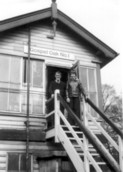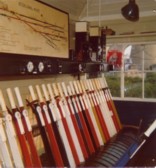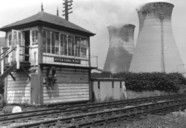
In 1971 I was appointed relief signalman based at Gospel Oak. After learning I relieved at Gospel Oak signalbox where the shift work, especially at night, was very busy with freight trains from and to the various Regions. When working early or late shift I had the regular passenger trains between Richmond and Broad Street on the electrified line, and also a regular diesel passenger service from a bay at Gospel Oak station to Barking. Broad Street has since been closed with trains running into Liverpool Street during peak hours, otherwise through to North Woolwich. Also during the day there were some freight and other trains which were in between the passenger trains. I also occasionally relieved at Finchley Road & Frognal Signalbox, near Hampstead Heath and Hampstead Tunnel.
Another signalbox that I worked in was Neasden Midland Junction, further on from Dudding Hill and which had a Midland type lever frame. There is a double line spur up from and down to Neasden South Junction on the Marylebone lines. I also worked the next signalbox called Acton Canal Wharf, the goods lines passing over on a bridge over the Euston main lines at Willesden Junction. From Acton Canal Wharf signalbox, which also had a Midland type lever frame, was a single line spur down to Willesden Junction Power Box. The next signalbox was Acton Wells Junction, which I never learned. It was where the goods lines join the electric passenger lines from and to Richmond, and also where is a connection with Acton Western Region goods yard, the Richmond lines being over the top of the Western Region Paddington main lines. I don't remember, but I expect that the lever frame at Acton Wells was LNW type as it was at Gospel Oak.
I often relieved at the new Marylebone Station Box, quite a large one, where the lever frame was a Midland type. The old Passenger Box that I had worked when I was on the Western Region and where the passenger trains were drawn by steam engines, had been scrapped, and also the Goods Box since the London Midland Region had taken over. Marylebone Goods Yard was no longer there. The signalling and railway layout had been changed and the passenger trains were now diesel trains. The first signalbox after Marylebone Station Box was Neasden South Junction, just over five miles away. The automatic colour light signals controlled sections between the two boxes. The illuminated diagrams at Marylebone Station Box and Neasden South Junction Box showed the presence of trains to and from about half way between the two signalboxes. Trains arriving and leaving Marylebone station appeared and disappeared at the tunnels, but of course being seen on the illuminated diagram in the box.

I also learned and relieved at Neasden South Junction where trains from and to Harrow-on-the-Hill and Aylesbury and trains from and to High Wycombe and Banbury had to be regulated when approaching the junction. The signals in that direction were ordinary semaphore signals. Some goods trains came down from or went up to the Neasden Midland Junction Box on the Midland goods lines. There were sidings and goods lines between Neasden South Junction and Neasden North.
Occasionally I relieved at some of the other signalboxes which I had previously worked when on the Western Region such as Neasden North, Sudbury Hill, Northolt Junction. and West Ruislip. I sometimes worked as pilotman on engineering work, usually at weekends, but on the London Midland Region we did not get the work as groundman or flagman as we had on the Western Region as that work was done by the Permanent Way staff. One of the signalboxes in the Willesden Junction area and in which I worked was Mitre Bridge Junction. The lever frame there was a LNW type. The signalbox was in the 'V' of the junction, the lines from and to Willesden Power Box passing the front of the box while the lines from and to Willesden High Level Junction passing behind the box, the two routes joining and crossing the main Western Region lines over a bridge, the signalbox from and to that direction being North Pole Junction. The junction signals near the bridge are electric colour light signals which I worked from the lever frame as the other signals which were ordinary semaphore signals and discs, also, of course being worked from the lever frame.

Most of the trains were freight trains from and to the Southern Region, including Freightliner trains, but on certain days in the early hours of the morning or late at night there were motorail trains for the holiday motorists from the South to Scotland and vice versa. The Motorail trains would change engines, at Willesden Power Box when going North and at Mitre Bridge Junction when going South. The Motorail trains were very long and I well remember when on nights, of the rear of the North bound trains being still outside Mitre Bridge box while the Southern Region diesel engine is being changed for a London Midland Region electric pantographed engine at Willesden Power Box. Before a south bound train was due I would receive a Southern Region diesel engine which I would shunt into a siding. When the train arrived the electric engine would be detached and sent back to Willesdon Power Box, as the overhead electric system terminates at Mitre Bridge. Then I would signal the SR diesel engine out of the siding and back on to the train. Having operated the necessary levers for the movement of the appropriate shunting signals and points, and having obtained 'line clear' on the appropriate block instrument from North Pole Junction signalbox I could pull off' for the train to continue its journey via Kensington and Clapham Junction to the Southern Region. Motorail trains also ran from the Southern Region passing North Pole Junction signalbox where the train was turned down to Old Oak Common Signal Box on the Western Region, and vice versa when from Western Region to Southern Region. I never worked as signalman at North Pole Junction, but at some time I think I did some work there during engineering works.
When I was working in the London area I was able to use the London Underground trains to take me to and from a station near to where I happened to be working, instead of going by car or motorcycle. The last signalbox I have to mention is Brent Sidings Signalbox, Willesden, which I learned and relieved as required. It is a large box which has a very long LNW type lever frame. Behind the box is a large shunting yard, the arrival goods lines and departure goods lines being at the front of the box. The freight trains were from and to various different Regions. The departure goods lines being very long for the long freight trains, the points at departure ends were electrically worked when I pulled or reversed the appropriate lever, the starting signals being electrical colour lights or ground signals.